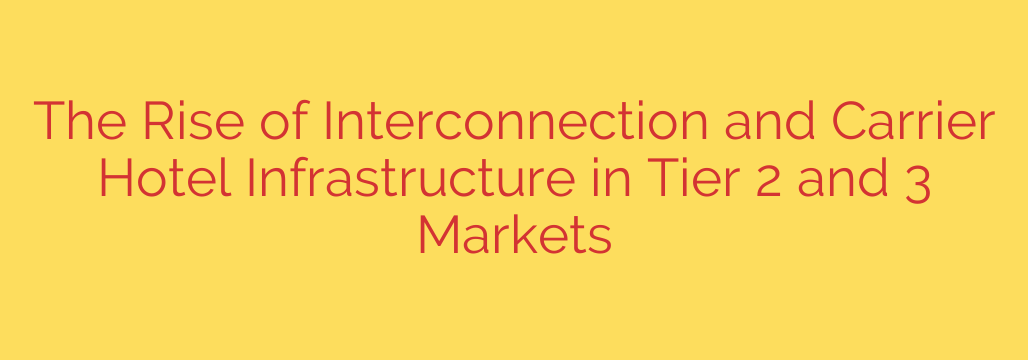
The digital landscape is rapidly evolving, pushing the boundaries of connectivity far beyond the traditional major metropolitan hubs. We are witnessing a significant surge in the development of robust digital infrastructure, particularly interconnection facilities and carrier hotels, within what were once considered secondary and tertiary markets. This trend is not merely a byproduct of growth; it is a fundamental shift driven by the increasing demands of a digitally transformed world.
Historically, the vast majority of data centers and key network points of presence (PoPs) were concentrated in large cities, often referred to as Tier 1 markets. This was where the internet’s backbone converged, facilitating rapid data exchange for major businesses and populations. However, as digital consumption grew exponentially and new technologies emerged, the limitations of this centralized model became apparent. The need for lower latency and higher bandwidth closer to end-users and businesses in smaller cities spurred a decentralized expansion.
Tier 2 and Tier 3 markets, encompassing medium-sized cities and even some larger towns, are now becoming critical nodes in the global network fabric. Businesses in these areas, regardless of size, require reliable and high-speed access to cloud services, SaaS applications, and their remote workforces. Furthermore, the rise of technologies like the Internet of Things (IoT), Artificial Intelligence (AI), and increasingly complex streaming services necessitates data processing and exchange much closer to the point of origin or consumption. This is where the concept of edge computing comes into play, and it relies heavily on localized, well-connected infrastructure.
The development of carrier hotels and interconnection hubs in these non-Tier 1 locations is crucial for facilitating this growth. A carrier hotel is a vendor-neutral facility where multiple telecommunications carriers and internet service providers (ISPs) can physically connect their networks. This creates a dense ecosystem of connectivity options. Interconnection itself is the direct physical link between these different networks, allowing data to bypass the public internet for faster, more reliable, and often more cost-effective transit.
By establishing these facilities in Tier 2 and 3 markets, businesses located there gain direct access to a multitude of network providers and cloud on-ramps without needing to backhaul their traffic hundreds of miles to a distant Tier 1 city. This dramatically reduces latency, improves application performance, and enhances the overall digital experience for businesses and residents alike.
Several factors are accelerating this expansion. Firstly, the ongoing build-out of new fiber optic cable routes is connecting previously underserved areas. Secondly, the increasing availability of dark fiber allows network operators to light up connections as needed, fostering greater competition and connectivity options. Thirdly, the demand for colocation space, where businesses can house their IT infrastructure in secure, connected facilities, is growing outside the traditional metros.
Investing in digital infrastructure in Tier 2 and 3 markets also brings significant economic benefits to these regions. It attracts technology companies, supports local businesses’ digital transformation, and creates high-skilled jobs. It levels the playing field, allowing companies located anywhere to compete effectively in the global digital economy.
While challenges remain, such as ensuring sufficient power availability and attracting skilled technicians in these developing markets, the momentum is clearly towards greater decentralization of digital infrastructure. The rise of interconnection and carrier hotels in Tier 2 and 3 markets is not just a trend; it’s a fundamental restructuring of the internet’s physical layer, essential for supporting the next wave of digital innovation and ensuring equitable access to high-speed connectivity across the country and globally. This distributed model of network density is critical for future resilience, performance, and economic opportunity.
Source: https://datacenterpost.com/expanding-horizons-the-evolution-of-interconnection-and-carrier-hotel-infrastructure-in-tier-2-and-3-markets/








